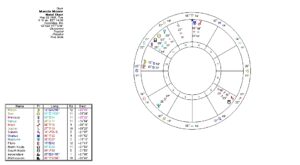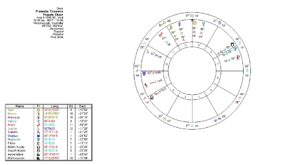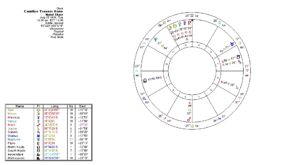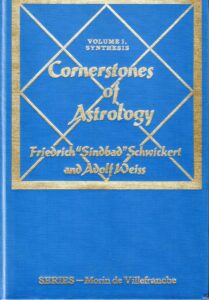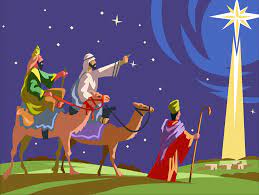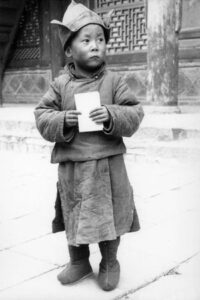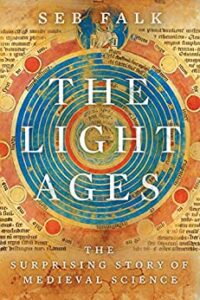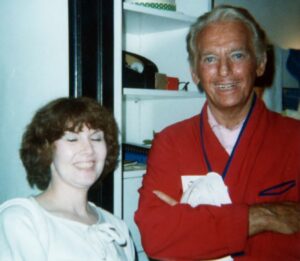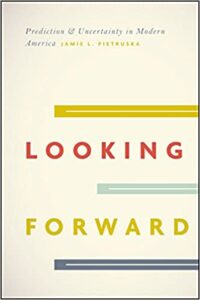A glance at the cover of the recent Marcia Moore biography and crime story tells us much about the publisher and authors’ bias. The astrologer and yoga teacher is presented as a disturbed, evil child, looking like Madonna playing Baby Jane. Apparently it’s still difficult to overcome the centuries-old feeling that occult and metaphysical practices are inherently immoral, and that practitioners are often unscrupulous con-artists or unstable drifters. 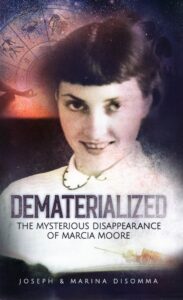
In Dematerialized: the Mysterious Disappearance of Marcia Moore, spouses Joseph and Marina DiSomma have capitalized on the current vogue for astrology and interest in the therapeutic use of psychedelic drugs. While they do not overtly disparage Moore’s practice of astrology, yoga or past-life regression, they nevertheless seem to present a morality tale about the dangers of involvement in the metaphysical sphere. Marcia’s disappearance and death in Washington state in 1979 at the age of 50 drives the book, which skews our understanding of Moore, her life and work.
Marcia Moore had natal Neptune squaring her Sun and Venus, and Neptune was closely trine her 10th house Jupiter. So it’s not surprising that Neptune would figure prominently in both her life story and the mystery of her death. When she disappeared, her progressed Midheaven was sextile her Ascendant and square natal Neptune, while transiting Neptune conjoined her singleton Saturn and opposed natal Mercury, ruler of her 3rd and 12th houses. It must have been a challenging and confusing time. Moore suffered from arthritis in a hip for several months before her death, and the previous year brought her experiential work with her husband on the dissociative drug ketamine, which has some hallucinogenic effects. (More on her chart here.)
The DiSommas did an enormous amount of research, had the full cooperation of the investigating detective and access to sheriff’s case files, a close friend’s diary and Moore’s letters. Marcia’s daughter, second husband Louis S. Acker and many other friends and family members also assisted the amateur sleuths with documents and information.
However the authors remain outsiders to the world of astrology, and, perhaps also due to their inexperience as writers, do not convey much empathy for their subject or understanding of her studies and expertise. While they acknowledge Marcia’s generosity and idealism, she’s often portrayed as a willful New Age zealot without a center. The true crime genre is dependent on its villains, and sometimes black-and-white judgments are also made on others in Moore’s life. While her horoscope shows she might expect notable relationship issues, her first husband is depicted as an alcoholic failure; her third as a sycophantic sponge, abuser and embezzler; and her fourth as a sexual abuse survivor turned drug addict who manipulated his wife and others for his own ends. As an M.D. he probably should have taken more responsibility for Marcia’s health while injecting her with the anesthetic ketamine regularly for six months while they worked on their book about it together.
And indeed, in August of 2022, a Moore family member said in an Amazon review that “descriptions of some individuals borders on libel,” and that the writers “filled their knowledge gaps with unfounded assumptions.” The fact that all of the principals are now dead may have added to the impulse to judge or fictionalize. As first-time authors, their prose is not the slickest. Much testimony is quoted verbatim, and the decision to leave misspellings “as is” often makes for an annoying read. The book is excessively annotated but there is unfortunately no index.
Astrologers and psychics who offered tips to the sheriff’s office are shown as complicating their efforts. Someone suggested Moore’s death was an assisted suicide, another that she simply dematerialized into another plane (hence the title). Some may have come close to indicating where the astrologer’s remains would later be found, but we still don’t know exactly what happened. The book suggests a solution to the crime and the authors make a somewhat plausible case for it, but their final witness and certain details are not the most compelling.
However the DiSommas fill in the background on Marcia’s family in Concord, Massachusetts, and their long-standing interest in Theosophy, astrology and meditation. They share the alleged perpetrator’s chart and provide some information on the horary asked of Seattle astrologer Dorothy B. Hughes as to Marcia’s disappearance (though the exact time is only given on Astrodatabank). There are lots of photos and we get a look at the New Age wave of the 1960s and 1970s. So if you can swallow the undercurrent of disapproval of Marcia Moore’s ideas and lifestyle, Dematerialized has something to offer.
Buy Dematerialized on Amazon.
About my reviews and links.


